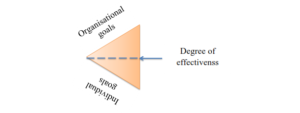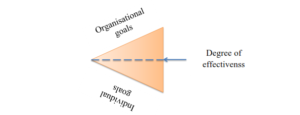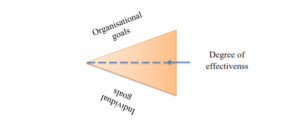Approaches to Measure Effectiveness
Organizational effectiveness should be measured because of two reasons:
1. Those who are responsible for the management of an organization should know whether their organization is doing thing rightly. If not additional efforts are required.
2. An organization is a means for satisfying the needs of people in the society and the satisfaction of such needs is directly linked to organizational effectiveness.
Certain approaches have been developed for measuring the effectiveness of organization. These are:
1. Goal approach
2. Behavioural approach
3. System-resource approach
4. Strategic constituencies approach
1. Goal approach
The goal approach states that an organizations effectiveness must be appraised in terms of the accomplishment of ends rather than means. The effectiveness of the organization can be measured in terms of the degree to which these goals are achieved.
Assumptions
i. The complex organizations have an ultimate goal toward which they strive.
ii. The ultimate goal can be identified empirically and progress toward it is measurable.
Campbell has suggested several variables which can be used in measuring organizational effectiveness. These are: , productivity, readiness, efficiency, profit or return, utilization of environment, stability, turnover or retention, accidents , morale, motivation, satisfaction, internalization of organizational goals, conflict-cohesion, flexibility-adaptation and evaluation by external entities. Thus there are many criteria but none of the single criterion has proved to be entirely satisfactory.
Limitations
i. With the exception of productivity, practically all variables as criteria of organizational effectiveness have been found inadequate and unsatisfactory.
ii. Goals as ideal states do not offer the possibility of realistic assessment.
iii. Goals as cultural entities arise outside the organization as a social system and cannot arbitrarily be attributed as properties of the organization itself.
2. Behavioral Approach
Behavioral approach takes into account the behavior of people in the organization which ultimately determines the degree of goal achievement by an organization.
Assumptions
i. Organizations as collectively of people have one set of goals and people as individuals have another set of goals.
ii. Degree of organizational effectiveness depends on the degree of integration of organizational and individual goals.
The integration of individual and organizational goals affects organizational effectiveness because each individual tries to satisfy his needs by working in the organization. Therefore, individual and organizational goal relationship may show a number of alternatives ranging from totally opposite to perfectly identical. In between these two extreme points, there may be three alternative levels of integration.
a) Low degree of goal integration
b) Moderate degree of goal integration
c) High degree of goal integration
a) Low degree of Goal Integration
In this case, when there is low degree of goal integration, that is, low degree of fusion score, the degree of organizational effectiveness is also low as shown in the figure below.
Individuals see their goals totally opposed to the organisation and consequently only one set of goals can be fulfilled at the cost of other. This results into low level of morale and performance. However this position cannot last for long because either the individual will leave the organisation or the latter may substitute the individual, depending upon the circumstances and the external environment, or organisation may go out of action.
b) Moderate degree of goal integration
In this case there is moderate degree of integration of organizational and individual goals, and consequently there is moderate degree of organizational effectiveness as shown in the figure below. In this case the organizational and individual goals are somewhat compatible but they are not exactly the same. The result of interaction between two sets of goals is a compromise, and actual performance is a combination of both.
c) High degree of goal integration
In this situation, there is high degree of integration between organizational and individual goals, and consequently high degree of organizational effectiveness as shown in the figure below.
In the third situation there is high degree of integration. Between organizational and individual goals, and consequently high degree of organizational effectiveness.
In this situation, individual goals are identified with the organizational goals. The climate of the organization is such that either of two things may occur. The individuals in the organization may either perceive their goals being the same as the goals of the organisation or see their own goals being satisfied as a direct result of working for the goals of the origination. Consequently closer the individual goals with the organizational goals, the greater will be organizational effectiveness.
Limitations
i. It does not really offer the criteria for measuring organizational effectiveness it only provides the clue for achieving effectiveness.
3. System-resource approach
System resource approach of organizational effectiveness is derived from the open system model. According to this model organization is an identifiable social structure or entity and relationship exists among external and internal environment of organization. There are various input and output transactions of various kinds relating to various things. These are scarce and valued resources which are the focus of competition between the organizations. The organization which attracts more input from the environment is more effective. Thus, organizational effectiveness is defined in terms of bargaining position, as reflected in the ability of the organization, in either absolute or relative terms to exploit its environment in the acquisition of scarce and valued resources.
Better the bargaining position of the organization, the more capable it is in attaining its varied and transient goals, and more capable it is in following the attainment of personal goals of its members.
Limitations
i. The theory talks about the acquisition of resources, this ultimately relates to some goals for which resources are acquired. However, the measurement of this goal is very difficult.
4. Strategic Constituencies approach
System constituencies approach has been derived from system resource approach with two major differences:
i. This approach considers only relevant environment of the organization under reference and takes into account those factors which have their impact on the operation of organization.
ii. This approach does not only consider taking inputs from the environment but exporting its outputs to the environment.
The organizational effectiveness depends on the degree to which the organization is able to satisfy these constituencies. In order to apply this approach, an organization has to:
i. Identify the relevant strategic constituencies and their impact on the organization.
ii. Identify the expectations of these constituencies and the way for meeting these expectations.
These strategic constituencies and their expectations may offer for different types of organizations based on the functions performed by them , in the case business organizations, these may be owners, management , employees, customers, suppliers, government and community. These are also known as interest groups.
Limitations
i. Strategic constituencies and their impact on organization are quite flexible and dynamic; they change over the period of time.
ii. It is difficult to identify the level of expectations of these constituencies and how these expectations can be fulfilled.
Factors affecting Organizational Effectiveness
Likert has classified the factors affecting organizational effectiveness into following three variables.
1. Casual Variables
Casual variables which influence the course of development within an organization and ultimately, its accomplishment. These variables are independent and include only those variables which can be changed by the organization and its management . since these variables are changeable, management can change these according to the need of the organization’s environment. Since environment is dynamic, management changes casual variables form time to time. The major casual variables in an organization are its strategy, technology, people and structure.
2. Intervening Variables
Intervening variables are those that reflect the internal state and health of the organization. These are mostly internally focuses and are used by the organization to judge whether it will meet its end result criteria. Intervening variables are generally grouped into three categories:
i. Product related
- Product quality and performance
- Product cost and price
- New products introduced
ii. Customer related
- Customer service
- Customer satisfaction
- Customer loyalty
iii. Personnel related
- Attracting and retaining human talent
- Personnel ability and skills
- Personnel motivation and attitudes to work
3. End-result Variables
These are externally focused and are often used to measure organizational effectiveness. The organization’s shareholders, customers, suppliers, financers and society at large are interested in these end result variables. End result variables are grouped into following four categories:
- Rate of growth
- Profitability
- Shareholder value
- Social performance
Organizational effectiveness through Adaptive Coping Cycle
The organization must develop a system through which it can adapt or cope with the environmental requirements. Edgar H Schein has suggested that an organization can do this through the adaptive coping cycle, which consists of various activities that enable an organization to cope with the dynamics of environment.
Adaptive-Coping Cycle is a continuous process. There are six stages in the adaptive-coping cycle as follows:
1. Sensing of Change:
The first stage is the sensing of change in internal or external environment. Failure to perceive changes in the environment or incorrectly perceiving the changes is the major factor responsible for the failure of the organization to cope with environment. Most of the organizations have adaptive sub-system such as marketing research, research and development and other similar devices for effective coping with the environment.
2. Importing the Relevant Information:
The systems approach views organization as input – output system and organization takes material, energy and information from the environment. However, the decision of what inputs will be taken from the environment is not a simple one. Organizations must be able to take the relevant information from the environment, which constitutes the input.
3. Changing Conversion Process:
The organization takes the inputs from environment for further processing, normally known as conversion process.
4. Stabilizing Internal Changes
The fourth stage of the cycle is to stabilize an internal sub-system of an organization, which is dependent on external, sub-system. This is because change in one may affect other and this change can be either positive or negative.
5. Exploring New Outputs
When the internal change is stabilized, the organization can export new outputs, which are in accordance with environment requirements.
6. Obtaining Feedback
The last stage in the cycle is to obtain feedback on the outcome of the changes for further sensing the state of the external environment and the degree of integration of internal environment. This is similar to first stage.
A successful coping suggests that all the stages have to be successfully-negotiated and failure at any of these stages may
Following are the major organizational conditions for effective coping:
- There should be an effective communication system through which reliable and valid information can be passed.
- There should be enough internal flexibility so that changes can be brought and absorbed by an organization.
- There should be motivation through effective leadership styles.
- Successful coping requires integration and commitment to organizational goals, which provide willingness for change.
- There should be supportive internal climate, which can support good communication, reduction in inflexibility and stimulation of self-protection.
- There should be complete involvement of top management
- Managing organizational effectiveness requires additional efforts, especially when the major organizational changes tale place.



